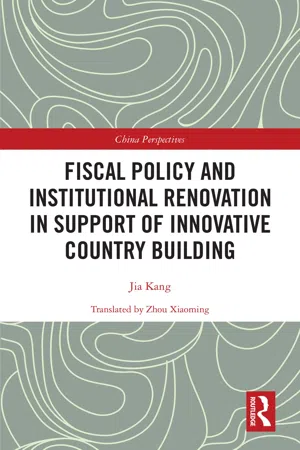
Fiscal Policy and Institutional Renovation in Support of Innovative Country Building
- 512 pages
- English
- ePUB (mobile friendly)
- Available on iOS & Android
Fiscal Policy and Institutional Renovation in Support of Innovative Country Building
About This Book
Since the onset of the twelfth Five-Year Plan, China has been at the forefront as an innovative nation based on a carefully designed strategy. Despite this, it can be argued that the Chinese government requires a series of more effective and systematic fiscal and taxation policies.
This book analyses the status quo and possible optimization of China's fiscal and taxation policies. By drawing comparisons with other countries, as well as a practical investigation into the lessons China has drawn from elsewhere, the author shows how a nation should make steadily growing and optimized financial investments in science and technology in order to foster the optimum environment for innovation. It is shown that institutional innovation should be a systematic project which involves top-level design and top-down leadership.
This volume will be a useful reference for students, scholars, and policy makes who are interested in financial policy.
Frequently asked questions
Part I
Theoretical study, practical investigation, and reference from international experiences on innovative country building
1 Literature reviews on independent innovation and innovative country building
1.1 International theoretical study on innovation
1.1.1 Technological innovation theory of J.A. Schumpter and Neo-Schumpterism
1.1.1.1 Innovation theory of Schumpter’s enterprise


technological innovation is endogenous of enterprises and technological progress is driving the long-term economic growth. The basic policy implication is that the speed, size and direction of technological innovation depend on the speed, scale, and direction of technological progress. More investment in R&D means more rewards on technological innovation.1
1.1.1.2 Technological innovation theory of Neo-Schumpeterian scholars
1.1.2 Neoclassical theory of economic development and technological innovation
1.1.2.1 The prerequisite and assumptions about market failure
Table of contents
- Cover
- Half Title
- Series Page
- Title Page
- Copyright Page
- Table of Contents
- List of illustrations
- Acknowledgements
- Preface
- Part I Theoretical study, practical investigation, and reference from international experiences on innovative country building
- Part II Fiscal and taxation support policies for building an innovative country
- Part III Systemic reform for building an innovative country
- Postscript: establish and improve a fiscal and taxation system conducive to scientific development
- Bibliography
- Index